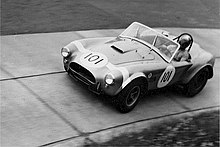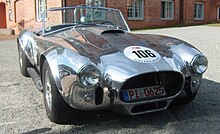AC Cobra
| AC | |
|---|---|
|
AC Cobra 427
|
|
| Cobra | |
| Production period: | 1962-1968 |
| Class : | Sports car |
| Body versions : | Roadster |
| Engines: |
Petrol engines : 4.3–7.0 liters (122–317 kW) |
| Length: | 3860-3960 mm |
| Width: | 1550-1730 mm |
| Height: | 1250 mm |
| Wheelbase : | 2290 mm |
| Empty weight : | 950-1150 kg |
| Previous model | AC Ace |
| successor | AC 428 |

The AC Cobra is a British sports car that was originally planned for racing. Production started in 1962.
The Texan Carroll Shelby developed the AC Ace model, built by the automobile manufacturer AC , which was founded in 1905 , after he had proposed to AC to build an American eight-cylinder into the Ace chassis. He made the Cobra famous. Shelby used a Ford engine in the car , which is why some Americans also refer to it as a Ford Cobra. Today, prices of over 1,000,000 euros are paid for an original Cobra, while a 427 “Super Snake” even achieved a record price of 5.5 million US dollars in 2007.
Development history of the AC Cobra
Ace production was already declining when the former American racing driver Carroll Shelby offered in 1961 to upgrade the car with a more powerful Ford V8 engine. The formalities were quickly sorted and Ford began supplying modified 4.3-liter V8s.
Shelby's suggestions were quickly implemented at the AC Thames Ditton plant, so that the first car was already on American roads in February 1962. It would have been easy to just put a V8 in the engine compartment. Instead, however, the frame was additionally reinforced and the power transmission and suspension adapted to the more powerful engine. In addition, the car that got Salisbury - differential and disc brakes from the Jaguar E-Type . A BorgWarner four-speed transmission took care of the power transmission.
The track has been widened, as have the fenders. This is how the typical Cobra slim, but muscular shape was created. The top speed was 240 km / h. The driving performance immediately led to racing successes in the USA. Encouraged by this, Ford became more involved and sent new development proposals to Thames Ditton , where the cars were delivered without engines.
The American racing program led to a number of innovations in the 1962 Cobra 289 with its 4.7 liter V8 engine and rack and pinion steering.
In January 1965, the Type 427 appeared with a 7-liter engine, 312 kW (425 hp) at 6500 rpm and a maximum torque of 641 Nm.
The development of the Cobra 427 had already started earlier. It was driven by the adventurous racing driver Ken Miles , who in 1964 installed a 427 cubic inch engine (approx. 7 liters displacement) in the chassis of a 289 Cobra. This Ford engine came from the NASCAR racing series. While the first use of this vehicle ended in a spectacular accident, the second professionally driven attempt was more successful. However, it quickly became clear that the previous Cobra was overwhelmed with this performance. Thus, with the help of specialists from Ford and AC-Cars, the vehicle was practically completely renewed. In contrast to the previous model 289, the 427 Cobra has a stiffer frame and coil springs with internal shock absorbers, the wheels are suspended from double wishbones. Depending on the intended use of the Cobra, the suspension was either in rubber (street versions) or in much harder bronze (racing versions or sporty street versions). The drive shafts and the brakes ( Girling disc brakes , front 292 mm, rear 273 mm diameter) were dimensioned much larger in order to correspond to the significant increase in torque and the increased top speed. In addition, the body has been widened again to make room for the wider 8.15 × 15 tires . The vehicles were still prefabricated in England and later painted and equipped with engines in the USA . Since the 427 was a lightweight engine for racing use, the Ford Motor Company sometimes had delivery problems for this drive. Therefore, a large part of the 427 Cobras was actually equipped with a 428 cubic inch. The 428 was slightly less powerful than the 427, with 265 kW (360 PS) available. Vehicles for the automobile sport were equipped with the 427. These also include the few 427 S / C vehicles built for homologation purposes, which left a lasting mark on the Cobra with its racing stripes and sidepipes. S / C stands for "Semi Competition", and so these vehicles were no longer far removed from a pure racing car. They differed from the normal Cobra in various details such as: B. instrumentation, the mentioned sidepipes or the waiver of comfort equipment. 50 of this model were built, 16 of which were modified to such an extent that they could be used as successful racing cars. Many Cobras were later converted into S / C “lookalikes”. A total of 348 vehicles of the Shelby Cobra 427 were built. Production of the Shelby Cobras ended in 1966. AC manufactured its own coil-sprung 289 version with the wider body until 1968, but then lost interest in this vehicle and developed less powerful concepts based on the Cobra chassis to sell in Europe . Shelby focused on the Shelby Mustang , based on the Ford Mustang Fastback.
Thus the production time of the vehicles with the name "Cobra" seemed to be over. However, Brian Angliss, founder of Autokraft in Brooklands , agreed with AC to continue the emblem and kept the shape alive. In the early 1980s, the Cobra reappeared as the AC Mark IV. Shelby American has been building Shelby Cobras since 1995 . These vehicles make few concessions to the modern registration regulations, as some of them are built in the USA with the original 427 engine. As a logical consequence, these vehicles have the chassis numbers CSX 4xxxx.
Cobra versions
- AC Cobra 260 : the original version from 1962 with a Ford 4.3-liter V8 engine.
- Cobra Mark II 289 : had the same structure as the first version, but was equipped with the 4.7-liter V8 engine from Ford and was the best-selling model in Europe.
- Cobra 427 : modified, reinforced variant of the Mk II, equipped with a 7-liter V8 engine and a top speed of over 250 km / h
- AC 428 : The Cobra-427 chassis with a new coupé or spider structure made of steel, designed by Frua in Turin. Produced exclusively by AC between 1966 and 1973 without any influence from Shelby.
- Cobra Mark IV : Revised version with stronger trellis tubes, disc brakes, five-speed gearbox and luxury equipment, manufactured by Autokraft from 1975.
History in brief
- 1961 The Texan Carroll Shelby, a former US racing driver, starts negotiations with AC Cars about the installation of a large V8 engine in an AC Ace with the support of the Ford Motor Company. The vehicle is built by AC Cars. The result is the AC Cobra, one of the fastest and most powerful sports cars ever built due to its extremely low power-to-weight ratio.
- 1962 The production of AC Cars focuses entirely on the manufacture of the Cobra. Each vehicle is built by hand.
- 1963 The production number reaches 15 Cobras per week.
- 1964 The AC Cobra sets a new world speed record of 183 mph (approx. 293 km / h) on the M1 motorway and is entered in the Guinness Book of Records as the fastest road car in the world. She has held this title for many years.
- 1965 AC Cobra wins the World Sports Car Championship. A speed limit of 112 km / h on US freeways will be introduced this year.
- 1966 AC Cars produces the 428, a seven-liter model with an Italian design by Pietro Frua from Turin. 29 convertibles and 51 coupes were built until 1973 when production was stopped.
- 1985 An improved 5.0 liter AC Mark IV is introduced and sold in the United States. It is produced with the original tools and corresponds to the American approval regulations.
- 1990 The "lightweight" version is introduced.
- 1997 The new AC Cobra Superblower is presented at the London Motor Show.
- 1998 At the Birmingham Motor Show a limited version of the AC MK II 289 FIA Roadster is presented and shown alongside the AC Ace and the AC Superblower.
- 1999 The new AC Cobra MK IV Carbon Road Series (CRS with carbon body) is presented.
- 2000 The new AC 212 S / C with a 3.5-liter twin-turbo V8 from Lotus is presented at the Birmingham Motor Show.
There are now far more replicas of the Cobra than original models. The qualitative spectrum is very broad. Very inexpensive and common replicas (as kit cars ) use axles and chassis parts from used or damaged Jaguar sedans and a four-cylinder Ford engine; the body often consists of a GRP laminate. In the past, copyright disputes have often broken out over these replicas. In some cases, they led to the prevention of approval for private buyers and builders of kit cars.
Technical data and measured values
In December 1983 a Cobra Mk IV was subjected to a test by the specialist magazine Auto, Motor und Sport . The new Cobra set a record in the AMS test history with an acceleration of 0–100 km / h. It was the first street legal car that sprinted from zero to one hundred in under 5 seconds. It wasn't until October 1984 that a Ruf BTR was even faster.
| model | engine | Displacement | power | Empty weight | Acceleration 0-100 km / h | Maximum speed | Consumption / 100 km | Factory price |
|---|---|---|---|---|---|---|---|---|
| Cobra Mk IV | V8 | 5752 cm 3 | 220 kW (300 PS) | 1220 kg | 4.9 s | 227 km / h | 21.5 l | 130,000 DM |
literature
- Trevor Legate: Cobra, The First 40 Years . Touchstone Books, Sutton Valence 2006. (English)
- German version: Cobra: the legendary sports car. Delius Klasing, Bielefeld 2008, ISBN 978-3-7688-1995-4 .
- Rinsey Mills: AC Cobra . Haynes Publishing, Sparkford 2002. (English)
- German version: AC Cobra: a homage to the English-American legend. Heel Verlag , Königswinter 2006, ISBN 3-89880-645-6 .
- Beki Adam: Cobra . Heel Verlag, Königswinter 1994, ISBN 3-89365-400-3 .
Web links
- Carroll Shelby's company website ( April 27, 2015 memento on the Internet Archive )
- Shelby American Automobile Club (English)
- Cobra Owners' Club Switzerland (German)
- Cobra IG Germany (German)
- Detailed report about the AC Cobra







